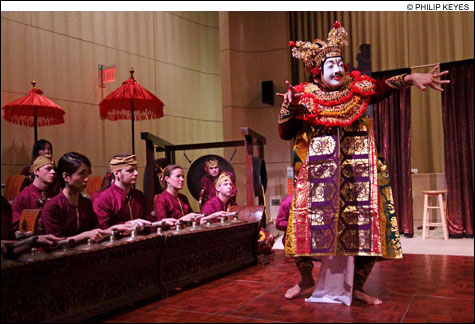
MASKED MAN I Made Bandem danced all the different roles in the traditional Topeng. |
The performance space of MIT's Broad Institute Auditorium last Saturday afternoon looked like the scrap pile at the local recycling center. Strewn over the floor were keyboards, laptops, cables, microphones, and the tuned brass bowls and low metallophones with ornate carved bases that make up a gamelan orchestra. This hodge-podge set the stage for a program of new and traditional works by Gamelan Galak Tika introduced by artistic director Evan Ziporyn.
The Balinese gamelan, a close-knit ensemble of percussion, flute, and voices, preserves some of the oldest music in the world as an essential part of ritual and secular occasions. Although its sound and organizing structures aren't anything like Western music, the gamelan can embrace cross-cultural influences and modern interpretations. New sonic adventures like these electronic collaborations keep renewing the tradition and warding off cultural paralysis.
Saturday's concert began with four new musical encounters. Midori Matsuo's ssss began with bursts of melody from a few instruments, almost delicate trills and pulses that got cut off on the way to sustained rhythm. Gradually more instruments joined, and they all worked up to an accelerating clamor that broke off and left a long reverberation. Then the piece moved back to a sparse coda.
Po-Chun Wang's Rice Combo featured quiet gongs and electronic voices, and the assurance that if you listened carefully, you'd become a great cook.
For Mars Rover & Snow White, Matsuo played a Western drum kit, with Larisa Berger on keyboard, Megan Tsai on double bass, and the composer, Christine Southworth, sampling vocals. As the rest of the gamelan pitched in, you could detect a basic rock beat substituting for the typical Balinese syncopations and jittery changes of speed, and the loopy vocals drifting in and out sounded like scat singing.
Evan Ziporyn has designed a small "beta gamelan" that's tuned in just intonation so that it can work harmoniously with Western instruments. For Agak-Agak, composer Ramon Castillo added an electrified bass (played by Blake Newman), an accordion (Matt Ven Brink), and an EWI (electronic wind instrument) that looked like a squared-off clarinet and was played by Eric Nugent.
But the star of Agak-Agak was the Heliphon, a tall stack of cylinders spiraling down a pole in the shape of a double helix. This robot lit up charmingly with tiny blue and green lights in response to its fellow players while emitting an assortment of sounds that must have been generated by the live musicians — clear dinging patterns like a xylophone or a celesta, low drones and organ chords, and a faraway chatter, maybe the Helicon's memories of a crowd of its siblings on another planet.
For the second half of the program the regular gamelan replaced the beta set, to accompany the noted Balinese dancer I Made Bandem in a performance of a traditional mask dance, Topeng. Behind a curtain, the dancer puts on a series of masks, each representing a different character type. Transformed by the mask, the performer dances a kind of aria expressing the character's role, his behavior, his power.
After anticipatory twitches and shakes of the curtain, the first character appears. Red-faced, bug-eyed, with a big black moustache, Keras is a rough and tough guy who fights other people's battles for them. He dips and rises in the movements of a warrior dance, then leaves with a tiny nod to the audience. Monyer, the next to appear, is a pale, androgynous figure who seems to smile as he advances. He circles the space with slow steps and tiny vibrations of the fan he sometimes uses as a mirror to admire himself.
The Dalem, a noble, elegant figure, would take the role of the king in a drama. His is the longest dance, as he surveys the audience, with striding assertiveness and stern admonishing gestures. After he leaves, a benevolent demon appears to clear the air, with invoking, threatening gestures, hoarse cries, and laughter.